The White Dudes of Liberalism

When a critical concentration of white men are present in early days of a movement or ideology, it sets in motion a vicious circle of attracting more white men and repelling others. This isn’t necessarily conscious. If a few white guys want to put something together, perhaps like a web publication dedicated to articulating, defending, and advancing liberal ideas, then a number of factors create a white dude clustering effect. Most of our social circles consist of white men. This makes the space marginally more comfortable for other white men to join and marginally less attractive to non-white-dudes. A woman, for example, may see the list of members or contributors and decide, reasonably, that she already lives in enough situations dominated by men. Meanwhile, the discussions produced by the early white dudes tend naturally to be about issues of concern to white dudes, framed in terms, language, and background assumptions conducive to white male comprehension.
I can’t over-stress how critical this problem is. A central concern of liberalism is figuring out how very different people can live together in peace, cooperation, and prosperity. Diversity is the root of the liberal project. When only the ideas and problems of a subset of the population are heard in a forum, then the central problem* of diversity — the problem liberalism is concerned with solving — is papered over.
It can be and often is argued that it doesn’t matter where political principles and solutions are discovered if they are true. And if liberal principles are really universal — as I have argued they are — then white men who just happen to be historically advantaged should be as capable of advancing these universal values as anyone else. The liberal philosopher Jason Brennan has even suggested that proportional political representation and political power for disadvantaged groups may do more harm than good, pointing to research showing both that people vote according to their honest assessment of the public good, and that members of advantaged demographic groups have policy views closer on average to those of policy experts.
This is a silly argument. While liberal principles can be abstractly theorized, in the real world establishing liberal freedoms and capabilities for oppressed and marginalized people has always involved close attention to institutional and cultural context. Maybe there is some abstract sense that— if you squint — “separate but equal” as a principle can have some veneer of liberal legitimacy. The rights and welfare of each individual are nominally respected, while pluralism and diversity are allegedly accommodated through sequestration.
Most of us understand that in reality this separation will inevitably entrench inequality, in addition to violating many basic freedoms in the process. I mention it only as a contrived example of how principles only get you so far when you empty them of the concrete details of how they are applied. Historical context matters at least as much as abstract principles, and the black citizens of Jim Crow America knew very well separation was a fig leaf for their continued marginalization and abuse. Dignity required access to the same institutions whites enjoyed.
Indeed, liberalism may best be understood not in terms of the abstract principles it elevates, but in terms of its actual practices as experienced in lived contexts, where liberal values are pitted against one another under the oppressive weight of history. Freedom of association — an important liberal value — serves the illiberal cause of segregation. Privacy shields oppressive and violent family relations from public scrutiny. Property rights perpetuate wealth inequalities between groups, translating into opportunity differentials and ultimately reinforced social status hierarchies. Liberal values, in illiberal contexts, can fortify existing relations of power and domination.
This is not suddenly an anti-liberal screed, but a recognition that context matters for achieving liberal ends. And we aren’t all equally capable when it comes to deciphering different contexts. Black perspectives are critical for perceiving when something that sounds unobjectionable to white folks — say, preventing voter fraud — is really a stalking horse for maintaining power relations contrary to liberal equality and freedom. Women’s perspectives are critical for detecting and understanding sexism. In short, diverse perspectives are necessary for understanding liberalism in application, and thus for understanding liberalism, full stop.
This is why it’s disturbing to write and edit for a publication dedicated to liberalism that has attracted mostly white and male readers and contributors. To stand a chance at doing justice to our mission, we need writers from more diverse backgrounds.
It’s a legitimate question, what do non-white-men even need liberalism for? It’s a question that is hardly unique to liberalism, various leftist strands suffering their own problems of being blind to inequality and oppression, while various traditions on the right aren’t even concerned with such potential problems. The “black radical liberal” Charles Mills points out in his essay “Occupy Liberalism!” that
Such racialization … is going to be a common problem for any American ideology with emancipatory pretensions. Liberalism is certainly not unique in that respect, as the history of the white American left and socialist movements illustrates. As Jack London famously put it at a meeting of the Socialist Party in San Francisco “when challenged by various members of concerning his emphasis on the yellow peril”: “What the devil! I am first of all a white man and only then a Socialist!”
Conceptually, the set of liberal values — moral individualism, pluralism, freedom, and equality — are consistent with critiques of social oppression. Indeed, liberalism is sometimes charged with failing under the withering critiques of feminism, for example, by failing to respect the full moral worth of women as individuals.
But the practices and institutions of liberalism also have the potential to serve social justice. Representative democracy has demonstrated a tendency toward increasing inclusiveness, however slow, agonizing, and beset with setbacks this progress may be. Markets and economic growth (along with scientific advances) have vastly expanded the real capabilities of people across classes. The birth control pill and the technological automation of domestic drudgery made possible by economic growth has, for example, facilitated women’s liberation in a material way. The modern welfare state, meanwhile, has moderated the dislocating effects of capitalism and trade. All of these institutions stand to improve, especially in ways that focus on the ways sexism, racism, and other marginalizing and oppressive forces have shaped society. The resources of liberalism are powerful, but an inclusive liberalism needs the input of diverse voices.
And so persons interested in contributing should inquire within: writers@liberalcurrents.com.
* Diversity is a problem to the extent disagreement represents a challenge for collective decision-making. But diversity also offers the advantages of multiple ways of looking at problems and generating solutions. Diversity is also just simply a positive value for many.
Featured image is The De Moucheron Family, by Pierre de Moucheron.




